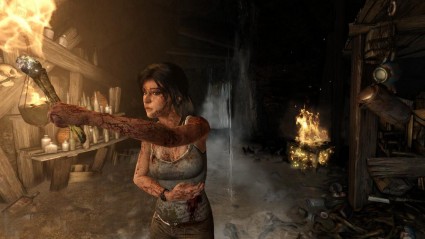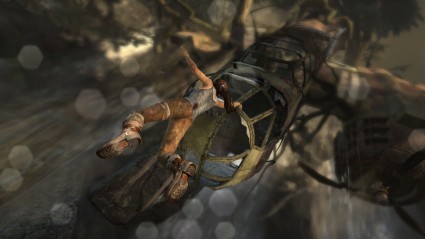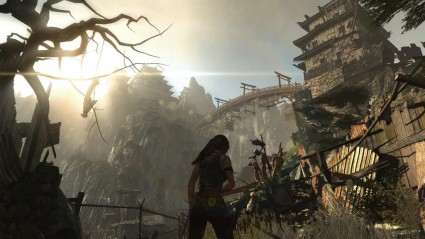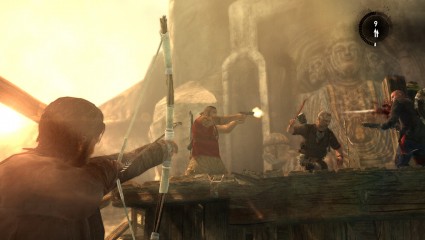Reviews
Tomb Raider (Definitive and Regular Editions)
February 3, 2014, Author: Andy Corrigan
There was a time when I’d have called Core Design and Eidos’ Tomb Raider one of the most important franchises in the industry. Our busty heroine, Lara Croft, grew well beyond her original aim as a fantasy object for young teen boys and became a pop-culture phenomenon in her own right. Gracing the covers of magazines, advertising countless products and coming to life in two movies, she almost could do no wrong – until 2003’s dire Angel of Darkness hit, that is, and then the wheels fell right off.
With Core Design removed from development duties as a result, Crystal Dynamics were the team tasked with bringing the old girl back to our attentions in 2006 with Tomb Raider: Legend. It was a decent game, certainly, but Lara’s relevance had already started to wear thin. By the time of their third game at the helm, the outdated Underworld, they’d been bested at every single level by Naughty Dog and the Uncharted series. With Lara’s image no longer what it was, the time was right for Crystal Dynamics to give Tomb Raider the fresh start it so desperately needed.
Thankfully, this reboot is so much better than I could ever have imagined, and the newly updated Definitive Edition on next-gen consoles provides a worthy facelift.
The Lara Croft that we knew is no more. No longer is she an exaggerated cartoon character and capable of handling every situation without breaking a sweat; this iteration sees Lara as more of a scholar with an insatiable thirst for archaeological knowledge, rather than adventure. With only basic and untested survival training behind her and zero combat experience, she’s going to have to learn to survive pretty quickly.
We pick up her story as she’s aboard expedition ship The Endurance, as she and her associates are searching for the lost island of Yamatai. The Endurance ironically fails to endure the storms surrounding the island as it crashes in horrific fashion on its murky beach, while Lara, separated from the rest of her group, is attacked and knocked out cold. When she awakens, she finds herself strung upside down in an ominous cave, surrounded by ritually-killed corpses. After making a somewhat painful and panicked escape, Lara sets about trying to find her friends so that they can regroup and escape, but first she must survive not only the island’s natural dangers, but an army of cultist militia who have an unknown stake in their presence.
The real strength of the story, though, is Lara’s personal growth throughout. Much has been said about the misdirected comments by a developer at a trade show and the in-game beatings that Lara receives, but this is not about torturing the young heroine for the audience’s pleasure, but about highlighting her inexperience. She feels like a real, relatable young woman now, and she’s fallible, especially early on. She’ll stumble and pay for being green, but she always learns from it and grows stronger because of it.
It’s still true that it’s a brutal game. You’ll wince with her every fall, you’ll feel uncomfortable for her at many times throughout as the island dishes out its beatings, but you’ll never want to ‘protect’ her; she’s strong enough to do that herself. It’s just that she’s only learning how capable she is as she goes. Seeing her skills and confidence develop as her hidden grit and courage shine through equates to one hell of a rewarding experience. By the end I felt like I’d taken a real journey with this version of Lara, in a story that’s far deeper than anyone would have given Crystal Dynamics credit for telling.
If there’s a complaint to be made about the plot, it’s that none of the other characters are as interesting or as compelling as Lara. The game just never gives you a chance to get to know them, but considering that this is her story, how she came to be, for me it’s entirely forgivable that the others take the backseat.

It doesn’t take long before Lara takes a battering.
While the tone is more grounded, the story grittier and more mature, this is still a game all about explosive action. It kicks off at an amazing pace as Lara escapes her first cave, and then it never relents. Horrific in all the right ways, even when the game takes to quieter, more puzzle-oriented moments, the feelings of tension, panic and urgency are overbearing and never really leave you. In my mind, Crystal Dynamics have created a true survival horror game in the purest, most literal sense.
Much of the emphasis on survival comes in the ways in which Lara develops her skills and acquires and upgrades her weapons as the game progresses. She will literally start with nothing but her wits, but quickly acquires a small pick-axe and a bow shortly thereafter, which are two of her most essential weapons throughout. The bow isn’t just there because they’re ‘in’ at the moment, but rather it’s the most versatile option at her disposal. Whether it’s using it for the intended deadly purpose or to create zip-lines and set fire to far-off flammable items, its inclusion is central to the experience.
Surprisingly, its versatility doesn’t leave the bow useless in combat and you definitely won’t just want to stop using it as soon as the first gun comes along. In fact, there are plenty of times where it’s the most sensible option in a fire-fight. For a start, headshots with the bow are silent, meaning that those opportunistic enough can down a group of enemies before the majority even get wise to their presence. Plus, once you can upgrade weapons, as I’ll go into shortly, the bow can have even greater impact…
Don’t worry, though; there are plenty of traditional, meaty firearms for Lara to get her hands on, and these are drip-fed to you as part of the story at regular intervals. The timing of these unlocks is perfect, rewarding the player for constantly pressing forward. No matter which gun you’re using, combat is an absolute joy, and moving Lara around the battlefield feels fluid and intuitive. A lot of the combat is cover-based, but it’s never rigid in the Gears of War or Uncharted sense, somehow feeling more organic and natural than its peers.
The enemies play their part in that, fighting Lara fiercely every step of the way, constantly pressing. Grenades and molotovs are flung regularly, leaving you unable to hide behind cover and hold your ground. While others keep you pinned, you’ll find runners charging at you whenever they get the chance. It’s a chaotic dance, perfectly mixing long and short-range combat, resulting in gunplay that’s never anything but exhilarating.
As much as we all love Uncharted, one criticism has been that when the armoured foes start coming in their droves, the combat becomes dull, with enemies requiring far too many rounds to kill. Tomb Raider somehow manages to avoid this completely. Yes, you’ll find armoured and shielded foes amongst the ranks of the machete-wielding bullet fodder, distance shooters, and explosive-throwing backpack wearers, but they require nothing more than strategy to put down for good.

Better start climbing!
Of course, it’s not all about the combat. Lara will have to climb, solve puzzles and navigate dangerous terrain in her adventure as she always has. This is also a tremendous amount of fun and somehow, in a lot of cases, it’s still action-packed and as adrenaline-charged as the combat is. With every last-gasp leap of faith, with every drop or climb, my heart was in my mouth. The game flows between its two dynamics flawlessly too, immaculately paced and balanced throughout.
What’s really great to see here is Lara’s confidence visibly grow as you play. The first time you perform any function, an obvious example being the first time you cross a fallen log, Lara will move slowly, panic and stumble. Yet by the fifth or sixth time, she’ll dart across with confidence unseen in previous attempts. She’s learning her skills just as you are.
The tombs that Lara became famed for robbing take a backseat to the story in this game, relegated (for most part) to optional missions. There are, however, many hidden tombs scattered around the entire island for you to locate and then, as the titles suggests, raid. This is where the thinkers will find their fun, with each tomb providing a puzzle before Lara can get to its secrets. You might be climbing, lighting up the environment as you go, using objects to open up paths or timing runs perfectly, but each tomb is well laid out and worth exploring when you come across them.
This brings me to Tomb Raider’s structure. Initially, the game almost hints that Yamatai is an open world, and in a sense it is, as you’re able to fast-travel between found locations using camp-fires. Heading back to previous areas, you’ll be able to unearth tombs and collectables that you might have missed or been unable to reach with your initial toolset. The thing is, the pace of the campaign is so good, that I’d wager most will wait until the plot has ended before venturing back, which is exactly what happened to me. Either way, it’s likely you’ll feel the urge to go back and explore.
As part of one of my favourite unlock systems in recent years, doing well in combat, finding hidden treasures and other collectable items will reward you with XP. Once levelled up, you’ll be given skill points to spend across a couple of skill trees when you happen upon the aforementioned campfires. There are three trees to expand Lara’s skills, covering Survivor, Hunter and Brawler capabilities.
The Hunter tree allows you to improve Lara’s aim or improve ammo capacity, while Survivor allows you to retrieve arrows, increase Lara’s agility when climbing, or get more loot from fallen foes (human or wildlife). The Brawler tree unlocks new close combat moves such as dodge kills, although my favourite here is the Dirty Tricks skill, which allows Lara to throw dirt in her attacker’s eyes after a bash of the scramble button. It’s simple, but very effective.
Also, when using camp-fires, you’ll be able spend salvage that you’ve found to upgrade your weapons. Whether that means upgrading their stability, giving them bigger capacity or less kick, there are plenty of ways to improve your arsenal. I hinted at it earlier, but those with the most impact come when improving your bow. Eventually you’ll be able fire explosive or fiery arrows, or make them armour-piercing, ensuring that you’ll keep coming back to it as your weapon of choice.
If there is one element that might put people off, especially in the early portion, it’s the occasional reliance on quick time events. Thankfully, they’re used to good effect and are well woven into gameplay, feeling daring and exciting in their implementation. The fact is, this is a game that rarely lets you take the backseat. Even when it takes a more dramatic direction, you’re still in control of everything you see in some way.

The pace means that moments like these make all the more impact.
Frankly, Tomb Raider is easily one of the best-looking titles I’ve played in both the last and new generation. You’ll obviously spend most of your time looking at Lara in some capacity, and it’s remarkable to see her as a realistic human now, a far cry away from her cartoon character model of just a few years back. Her colleagues and attackers also both look fantastic, whether in cut-scenes or in the shaky hustle and bustle of gameplay.
It’s the island that remains the star of the show, though, looking incredibly impressive at every turn, and doesn’t the game just know it. Every chance it gets, the camera will shift in a divine fashion, offering you every opportunity to breathe in its rich and lively backdrops. Even as you’re navigating, the environment looks terrific, whether it’s the foliage blowing softly in the wind, the wonderful rain and lighting effects in play or just the impact of everything falling around you. There’s always something to catch your eye or admire. With no technical issues either, I think this more than most – especially in regards to the initial release – speaks volumes for publishers allowing developers the additional time to polish their game.
The Definitive Edition then, bolstered by additional power behind new hardware, takes an already striking game and makes it even better looking. The difference is clear, whether it’s major overhauls like the crisp, higher resolution; richer, more detailed textures; or more subtle improvements like Lara’s more believable hair movement (boy is it shiny!). The Definitive Edition does what it intended to do and that’s to look visibly superior. Ultimately, however, beyond the visual upgrade, that’s all it really achieves. Despite including all the DLC from the standard versions, the difference in actual content between last-gen and current is pretty negligible, outside of a new tomb and some costumes.
Tomb Raider stirs with its dramatic and sweeping original score that not only helps to provide great atmosphere, but also nails the emotional highs and lows of Lara’s adventures on Yamatai. If I had one complaint, it’s that it could be said that it sounds a little too similar to Nathan Drake’s musical backing; however, it’s a more subtle soundtrack overall. I also would have loved to hear some reference to the original Tomb Raider soundtrack thrown in there, but it’s a successful reboot, so you can’t really complain.
The voice-acting hits all the right notes, with Camillia Luddington really excelling in her vocal performance. Her Lara is human, compassionate and entirely believable, despite the larger-than-life nature of her circumstances. It’s a shame that the same can’t be said for the other key characters that, while doing a perfectly fine job, simply lack her level of characterisation. The other British accents in particular are just not quite right, but it’s a pleasing performance overall.
Elsewhere, the action is laden with big, brash sound effects. The guns sound lovely and chunky, buildings crumbling will unnerve, while explosions and shrapnel pinging around the battlefield all have great impact. Even the peaceful drone of the jungle wildlife in the quieter periods manages to keep everything feeling alive.

The token multiplayer isn’t much fun in spite of nice ideas.
Unfortunately, Tomb Raider doesn’t quite represent the complete package, with a severely lacking multiplayer component that feels forced in to appease publisher wishes. At best it’s ropey fun; at worst it’s messy and annoying.
Its major problem is that as fun as the single-player mechanics are, they don’t work so well in online versus combat. The running and climbing itself is fine, but combat feels awkward and muddled. Also, lag is unfortunately rampant and distracting. In the few matches I played, problem players would literally be teleporting all over the screen.
The game modes outside of Free for All and Team Deathmatch go some way to salvaging the online competent, though. “Rescue”, for example, sees a team of Survivors trying to steal supplies from Solarii camps. The Survivors need only five medi-packs to win, while the defending Solarii must either prevent that from happening or score twenty execution kills to end the round early. “Cry for Help” is also another solid team-based mode, where the Survivors must activate three radio transmitters by holding the ground around them. Once again, the Solarii can end the round themselves if they can collect twenty batteries dropped by dead Survivors. Both modes have a nice ebb and flow, but sadly, they’re ruined by the technical issues.
Just wow…
I was sceptical going in, but I’m pleased to say that the new Tomb Raider is a classy, action-packed masterpiece that entertains on every possible level. The plot is smart with explosive pace and left me with few bones to pick, while the smooth exploration and vicious combat sequences never failed to keep me glued to my controller. Not even the token-gesture multiplayer effort can bring it down. An essential purchase if ever I’ve played one.
The Definitive Edition, which is essentially Tomb Raider in its Sunday best, is definitely the way I’d advise folks to go if they’ve not yet had the pleasure of visiting Yamatai, or even if they’re simply desperate to replay through Lara’s punishing quest. However, if your only option is to play on last-gen consoles, then worry not; you’re still getting the same thrill-a-minute adventure, just it’s not quite as pretty as the updated package.
No matter your platform of choice, this Tomb Raider is well worth your time and money; a spectacular adventure that I enjoyed just as much this second time around.
Platforms: PC, PS3, PS4, Xbox 360, Xbox One | Tagged bow, Climbing, Lara, Lara Croft, Solarii, Survive, Survivor, Tomb Raider, Tomb Raider Reboot, Tomb raiding, Uncharted



